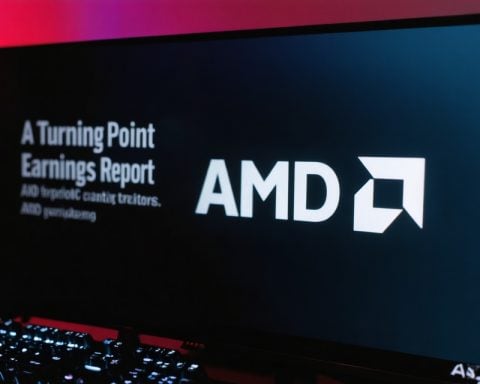- Nvidia is set to report potentially record-breaking earnings, with forecasts predicting a 73% increase in revenue to $38.32 billion.
- The company’s success is driven by high demand for its advanced data center chips, particularly the Blackwell platform, reinforced by significant AI investments from Meta, Alphabet, and Amazon.
- Challenges include potential U.S. tariffs on chip imports and competition from China’s DeepSeek, which could impact Nvidia’s market position.
- Despite these hurdles, Nvidia’s ventures into quantum technology and robotics, along with AI growth, suggest a bright future with projected 52% earnings growth.
- Analysts and investors are optimistic about Nvidia’s prospects, expecting its valuation to potentially double over the next five years.
As anticipation builds, Nvidia prepares to unveil its earnings, poised to transform investor perceptions with potential record-smashing figures. Forecasts point to an unprecedented $38.32 billion in revenue, marking a 73% leap from the previous year. Analysts label Nvidia a formidable “buy,” projecting its share price could soar 26% beyond its current value, despite encroaching shadows.
The secrets behind this anticipated success lie in robust demand for Nvidia’s cutting-edge data center chips, especially the renowned Blackwell platform that promises to redefine industry standards. Giants like Meta, Alphabet, and Amazon are fueling this momentum by boosting investments in AI infrastructure, a domain Nvidia dominates.
However, not all is serene on Nvidia’s horizon. Whispers of new U.S. tariffs, allegedly under consideration by former President Trump, pose a fundamental threat—the potential impact on chip imports could ripple across markets. Meanwhile, DeepSeek, a Chinese contender, lurks with AI models that challenge Nvidia’s supremacy by requiring less monumental computing power, unsettling investors and nudging NVDA stock downwards since early January.
Yet, hope endures. Analysts remain convinced that Nvidia’s momentum, driven by its bold ventures into quantum tech and robotics, will eclipse current uncertainties. Market aficionados speculate that AI’s accelerated growth can sustain Nvidia’s trajectory, possibly even doubling its valuation in the next half-decade, riding on a forecasted 52% earnings growth.
The narrative unfolding is volatile; at its core is an industry leader threatened yet unbowed. Will Nvidia emerge unscathed from the crosshairs of competition and policy? Investors and analysts alike await with bated breath to see if this silicon giant can weather the storm and continue its dazzling ascent.
Nvidia’s Prospects: Are Record Earnings Just the Beginning?
How-To Steps & Life Hacks
For investors considering entering the semiconductor market or increasing their holdings, here are a few steps to make informed decisions:
1. Conduct Thorough Research: Before investing, study Nvidia’s recent earnings reports, market forecasts, and any external market conditions that could affect its financial health.
2. Analyze Competitor Performance: Compare Nvidia with its competitors, like AMD and Intel, to gauge its relative strength and market position.
3. Assess Technological Advancements: Keep abreast of Nvidia’s latest technologies, such as its Blackwell platform, to understand its competitive differentiators.
4. Stay Updated on Policy Changes: Keep an eye on policy developments, particularly U.S. tariffs, which can significantly impact Nvidia’s operations and profitability.
Real-World Use Cases
Nvidia’s GPUs and AI chips are increasingly vital across various sectors:
– Data Centers: Major organizations like Alphabet and Amazon rely on Nvidia’s chips for AI processing and data management tasks.
– Automotive: Nvidia’s autonomous vehicle technology accelerates innovation in self-driving cars.
– Healthcare: Nvidia’s technology aids in processing vast amounts of medical data for faster diagnostics.
Market Forecasts & Industry Trends
The semiconductor industry is projected to grow robustly, supported by the following trends:
– AI Explosion: With AI continuing to permeate numerous industries, Nvidia is set to benefit from its strong presence in the AI chip market.
– Quantum Computing: Nvidia’s ventures into quantum technology suggest a leading role in future computing paradigms.
– Sustainability Efforts: As environmental concerns rise, Nvidia’s engagement in energy-efficient computing may serve as a strategic advantage.
Reviews & Comparisons
Nvidia’s rivalry with companies like AMD and Intel is worth monitoring:
– Performance: Nvidia often leads in GPU performance, which is crucial for data-intensive applications.
– Cost: Depending on the product, Nvidia can be more expensive, but its performance often justifies the cost.
– Innovation: Consistent technological advancements have kept Nvidia at the forefront of the GPU market.
Controversies & Limitations
– Geopolitical Tensions: Potential U.S. tariffs and international trade barriers could disrupt Nvidia’s supply chain and sales.
– Competition: Companies like DeepSeek present emergent threats, particularly with efficient AI models.
Features, Specs & Pricing
– Blackwell Platform: Expected to revolutionize AI processing with greater efficiency and power.
– Pricing: Nvidia’s high-performance chips command a premium, which reflects their advanced capabilities.
Security & Sustainability
Nvidia is investing in:
– Cybersecurity: Ensuring their systems are secure against external threats.
– Sustainable Practices: Developing energy-efficient technologies to reduce environmental impact.
Insights & Predictions
Analysts predict:
– Continued Growth: If Nvidia can navigate external pressures, its stock valuation could double in five years.
– Expanding Market Share: As AI grows, so will Nvidia’s influence and market reach.
Tutorials & Compatibility
– Developer Tutorials: Nvidia offers resources for developers to integrate its technology into custom applications.
– Product Compatibility: Devices with Nvidia chips maintain compatibility across various platforms and ecosystems.
Pros & Cons Overview
Pros:
– Market leader in AI and GPU technologies.
– Strong financial growth potential.
– Wide applicability across industries.
Cons:
– Vulnerability to geopolitical tensions.
– High competition from global players.
Actionable Recommendations
– Diversify Investments: While Nvidia presents a promising opportunity, consider diversifying across the tech sector to mitigate risk.
– Monitor Policy Trends: Changes in tariffs or trade policies could impact Nvidia’s profitability.
– Explore Innovations: Stay informed about Nvidia’s technological advancements to leverage new market opportunities.
For more information, visit Nvidia and explore their latest news and developments in AI and computing technology.



















